The terms “phono” and “line” are often misunderstood, particularly by new record collectors.
Understandably, phono inputs can confuse music enthusiasts as they use the same RCA connectors as the inputs and outputs labels as “line” or “aux” on turntables and amplifiers.
So what’s the difference between phono and line signals?
Fortunately, it’s easy to boil this question down to a simple explanation, after which you’ll understand the basics and can get back to spinning records.
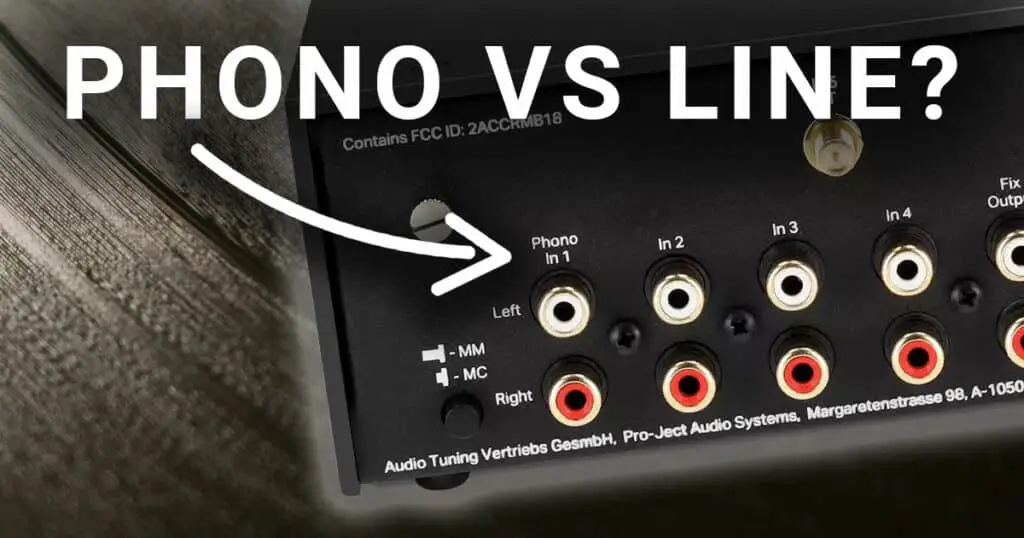
Phono vs Line Input – The Basics
In short, line and phono sources share the same RCA connectors; the difference between line and phono signals lies in the level and frequency response.
Phono inputs on hi-fi equipment are specifically designed to handle the low-level signal output from a turntable’s phono cartridge, while line (sometimes labeled aux) inputs are intended to handle higher-level signals that come from other audio sources such as a CD player or tape deck.
The phono-level signal from your turntable requires additional amplification and equalization compared to line inputs to properly boost and shape the sound from a turntable’s phono cartridge, which has a much lower output level and a different frequency response compared with other audio sources.
Phono inputs on amplifiers and receivers are expecting this very low, tinny signal, and will perform the task of boosting and balancing the signal so that it’s suitable for playback. This task is performed by a phono preamp (more on this later).

If your turntable is switchable to a line output (as pictured above), then it has a built-in phono preamp and you have the option to go straight to an input labeled “line” or “aux” on your amplifier or receiver.
So in very basic terms, that’s the crux of it. Now for some detail…
Phono vs Line Input – The Detail
Signal Level: The signal produced by a turntable cartridge depends on the type of cartridge in question.
For a typical moving magnet (MM) cartridge, the output level is generally between 3-6 mV (Millivolts).
For moving coil (MC) designs, the output is even lower (typically between 0.2 and 1.5 mV, with anything over 1.5 mV considered “high output”.
The standard level for consumer audio equipment is -10 dBV, which is .316 volts. Therefore, the first role of a phono preamp is to boost the very weak cartridge signal up to the consumer line level standard.
As you can see, MC cartridges need boosting significantly more than MM designs.
| Signal Type | Operating Level |
| Moving Magnet Cartridge | Typically around 3-6 mV (Millivolts) |
| Moving Coil Cartridge | Typically between 0.2 and 1.5 mV |
| Consumer Line Level (CD, Tape, Aux, etc.) | -10 dBV, which is .316 volts |
Frequency Equalization: Vinyl records are cut with the bass frequencies reduced and the high frequencies boosted. This equalization helps to permit longer recording times by keeping groove dimensions small, while also increasing sound quality and decreasing record wear.
This applied equalization is standardized through the Recording Industry Association of America (RIAA), and therefore the equalization curve applied is referred to as the RIAA Equalization Curve.
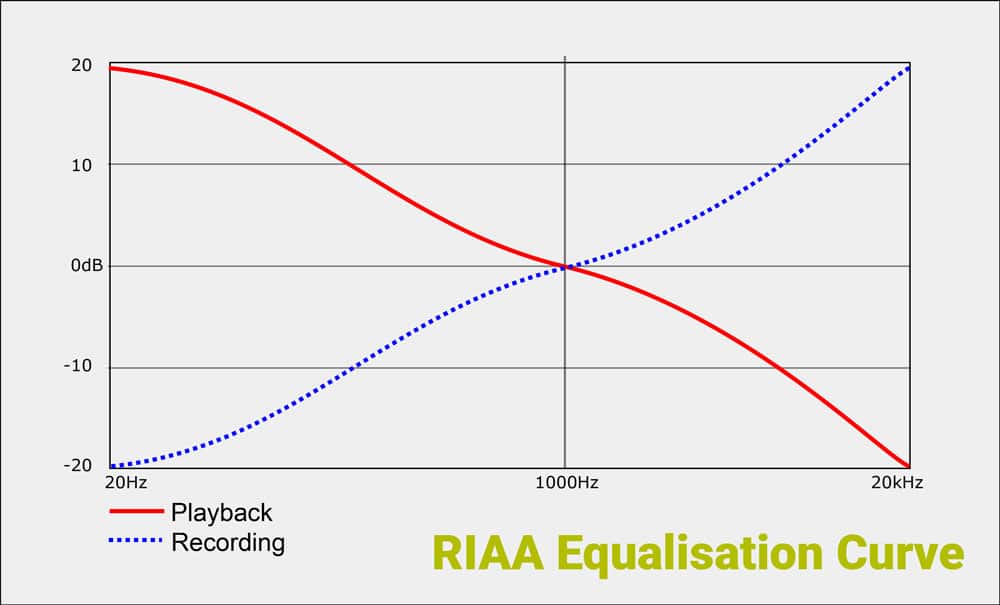
Before the RIAA Equalization standard was established (roughly 1954), each record company applied its own equalization standard…. what a mess!
A phono preamp applies the inverse of the RIAA equalization curve during playback to — as close as possible — to restore the original balanced sounding recording. (Click here to learn more about turntable phono preamps and how they work).
Do I Need a Phono Preamp?
The short answer is yes, in most cases.
If your turntable doesn’t have a phono preamp built-in, you will require a phono preamp to connect your turntable.
A phono preamp can be built into your amplifier or receiver (the input labeled “phono”), or you can purchase an external phono preamp to sit between your turntable and amplifier.
You’ll quickly know if you’ve connected your turntable incorrectly to a line-level input as your records will sound extremely quiet and very tinny (as touched on earlier in this article).
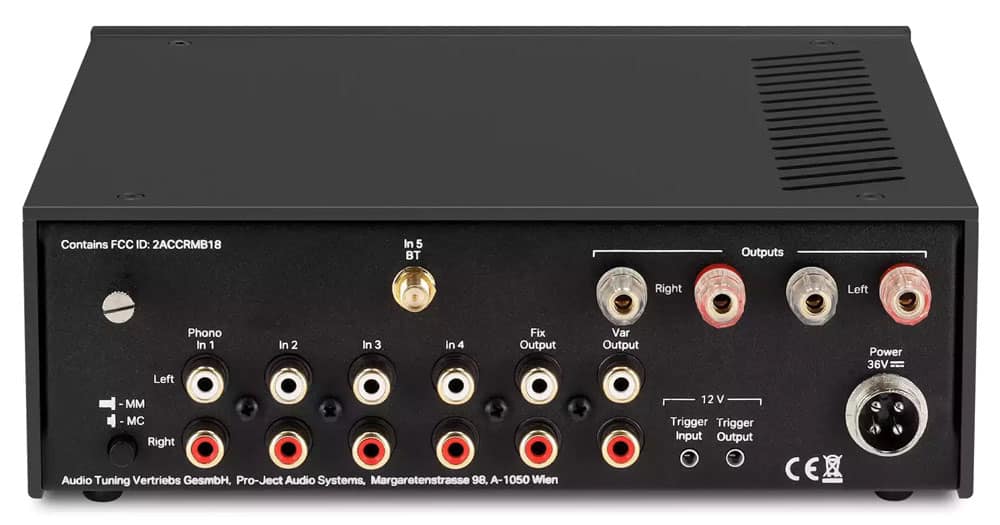
There is, of course, one exception to this rule: Bluetooth. If you’re running a turntable with Bluetooth connectivity, then you can, of course, simply connect to your Bluetooth speaker or Bluetooth-enabled amplifier and the whole conversion from a phono to a line-level signal is handled for you.
Is An External Phono Stage Better?
It depends on the quality of the built-in phono preamp, but in most cases, an external phono stage will deliver improved sound quality, increased flexibility, and modular upgradability.
Many external phono preamps, for example, allow for greater control over the sound, such as adjusting the gain, impedance, and capacitance to suit different cartridges and turntables, which can result in better sound quality.
In addition, some external phono preamps include a handy USB output to make hooking your turntable up to a computer simple. Why would you want to do this, you might ask?
Many collectors like to archive some of their record collection as digital files. This is handy if you want to capture a particular pressing or record that’s difficult to find in the digital realm or, for instance, when you simply prefer how the record was mastered compared to its digital counterpart. Check out our full guide on how to record vinyl to your computer to learn more.
The Rega Fono Mini A2D (pictured below) is a great-sounding, affordable, and compact phono preamp with USB output for handy computer recording.
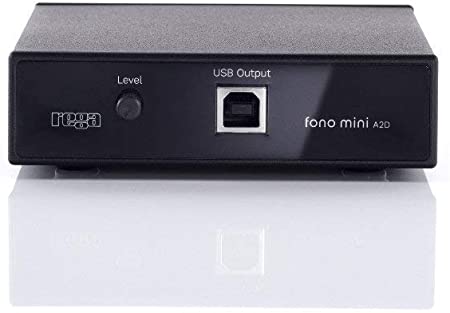
In general, external phono stages tend to have better component quality and design, making them a good option for serious audiophiles who want the best possible sound quality from their turntable.
If you happen to have a turntable equipped with a high-end, low-output moving coil cartridge, you will certainly need an external phono preamp capable of applying the additional gain stage required for moving coil phono cartridges. (More on the difference between standard Moving Magnet and Moving Coil cartridge designs, here).
Phono vs Line: Summing Up
As covered in this article, the difference between line and phono signals is signal level and frequency equalization.
Many people who’re new to collecting records or have never owned a turntable understandably make the error of plugging a turntable straight into a regular line-level input.
After all, the connections look the same, albeit for the “phono” label.
Plugging directly into a line-level output without using a phono preamp will result in a weak, thin sound that is essentially unlistenable.
The phono stage you choose can be built into your turntable or amplifier/receiver, or you can purchase a separate external phono preamp.
More expensive phono preamps are typically better quality and give greater flexibility. And, don’t forget, moving coil cartridges require a phono preamp capable of sufficiently boosting the lower output of such cartridges. Some phono preamps are designed to handle just MM or MC, while others are switchable between the two.

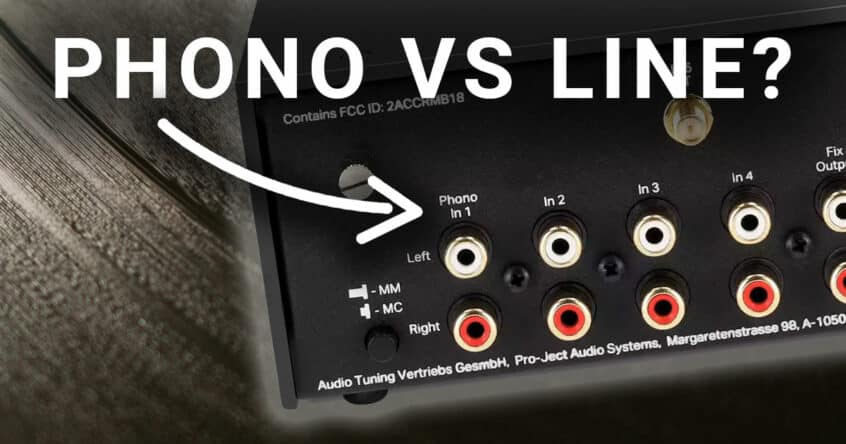


I have a fairly old Marantz receiver. It has what Marantz have called analog inputs, is that the same thing as line input. Reason for the question is that I have tried connecting a Marantz turntable with a built in equalizer to an analog input, it is barely audible. So I bought a pre-amp and plugged that into the analog input, but that just seems to cause the receiver to shut off (like it has a fault). I then have to cycle the power to get it working again
Hi Neal. Without knowing the model number, it’s hard for me to say exactly what you’re looking at. But yes, I would assume “analog inputs” are line inputs unless otherwise labeled. Your Marantz turntable with built-in phono input most likely has a switch somewhere where you can turn the phono stage on or off. No line or phono input should affect the power, so I’m a bit lost as to what is happening with your amp’s power. Sounds more like a fault to me. Hope this helps.
Thanks for a very helpful article, I hadn’t used vinyl for years and just recently bought a Denon mini hifi bundled with a pair of Dali speakers, I also bought an Audio-Technics turntable which has a phono/line switch, I have it on line and it works but there is a slight hum on it.
I will look into a pre amp and check grounding options.
Hello. Thank you very much for the article. I have a audio-technica turntable with built-in amp and a line input in Roksan amp but the sound is about 40% weaker than my bluetooth source. Would you recommend using an external amp? In such case, shall i use the Line option in my turntable to drive my external amp?
Hi and thanks for the enlightening clarification between Phono and Line-in
I was wondering if I had an early 80’s boombox radio and in the radio is a “Phono” connection (No Line-in at all) and I would like to play music through bluetooth with the radio.. The source being phone or laptop, from there to an external bluetooth-receiver and from the receiver through RCA-cables into the radio “Phono” connection. Is this appropiate/safe? Is it something that shouldn’t be done or actually doesn’t matter at all? If it would be “Line-In” I wouldn’t hesitate at all, but the “Phono” makes me question a bit…
Any answer would be appreciated, thanks!
I suggest you list the line level as 316 mV rather than 0.316 V so that it’s easier for people to compare levels. There are very likely readers who don’t know how to use technical units.
seriously ? How many people who can’t comprehend .3v = 300mv even understand the point of gain anyway ?
Great article, Marc! I have Cambridge Audio Topaz SR20 Stereo Receiver with MM Phono, but it is still about 20% quieter than CD’s. My player is Project 1Xpression with Ortofon blue. Would you recommend getting External Phono Stage, and if so, do you hook it up with the Phono or Line/Aux?
Thanks Kris. Generally speaking, external phono stages are a good idea if you’ve got the budget. There are always compromises when a box does everything in one housing. That, and there’s more potential for noise when components are close together.
Regarding the volume stuff, this could simply be the difference between how your records/CDs are mastered. If the CDs have more brickwall compression, then they will likely have a higher perceived loudness.
I’d base my decision to buy an external phono stage on sound quality more than anything. Hope this helps.
Hi Marc,
Which is the ideal socket to plug in the phono stage, or does it not matter?
And is there a way of reducing the electrical hum I get when I turn the volume up to near to max?
Hi Roger. Anything not labeled “phono” will be line level, so “AUX, LINE, IN, CD” etc are just labels and are all the same level.
Group loop hums on turntables can be a real pain. Do you have the ground loop cable connected firmly from the turntable to the phono preamp?
This is one of the BEST EXPLANATION that shows the difference between the ‘Phone Line’ and the ‘Line’ inputs in a receiver-amplifier. Excellent job!
Thanks Ferdinand. I’m glad it ticked the boxes. Happy spinning!